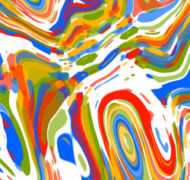Can Art Make Workers Happier?
Blog / Produced by The High Calling
I decided to spruce up my drab office with a colorful and enigmatic modern art print. It wasn’t anything notable, just a little something to add some flair to my everyday work environment. I imagined it would also make an important statement, alerting co-workers to my sophisticated and distinctive taste.
“What the heck IS that?” inquired one of my more forthright colleagues, cocking his head this way and that trying to make sense of the multi-patterned swirls. He plopped down into a chair and nodded his head towards it. “That is one of the most ridiculous, pointless things I have ever seen.”
I counted this a solid victory, further validating my astute selection of artwork.
Some businesses are tuned in to art and beauty as an important corporate value, expressed with bold colors, funky architecture and plentiful displays of art gracing the walls. Others, like my lug-headed colleague, not so much, unless you’re talking about the occasional $6.99 motivational poster.
Last month I had an opportunity to get a private tour of SEI Investments, a company so committed to art, the entire office campus doubles as an art museum.
Seriously.
SEI is in the business of running back-office administrative platforms for investment funds, headquartered in a series of buildings located in a sleepy suburb outside of Philadelphia. Under the leadership of founder Al West, the company has grown to become the top player in its industry.
Upon arrival at the corporate lobby for my tour, I was asked to sign in and was then promptly greeted by the curator.
Wait, what?
Yes, there is a full time curator on site, which tells you this is more than just an eccentric entrepreneur’s hobby. Here at SEI resides the West Collection, co-existing right alongside the company’s 2,500 employees. Pieces of contemporary art are thoughtfully displayed throughout the corporate offices—on walls, in stairwells, at drinking fountains, hanging from ceilings, sneaking up on you in intermittent spaces—in the midst of the buzz of office workers coming and going about their business.
Mr. West was interested in more than just hanging pretty pictures around the offices. He aspired to develop a collection of provocative images that would challenge and generate discussion. He asked his daughter, Paige West, an art historian, to develop a collection. It now counts over 3,000 pieces, focusing on emerging artists who are breaking new ground. “The collection’s intent is not to aesthetically please, but to make one think,” says Mr. West. To him, the purpose of art is to act as a catalyst, a means to challenge, inspire, and perhaps even bother the viewer.
It was slightly disorienting for me at first, this odd mash up of corporate business and of-the-moment contemporary art. I tried to imagine working in such an inspiring environment, surrounded by such creativity, such beauty and whimsy and intrigue at every turn. I wondered, do the workers here even appreciate it? Do they lose the wonder and magnificence after passing by the same old piece for the hundredth time?
I’ve heard that when under pressure or a deadline, something as simple as walking outdoors and staring at a tree can re-calibrate your brain neurons to alter perspective and reduce stress. Is the same also possible with art? Sometimes I can look into a painting and get lost in the color, drown in the infinite possibilities of shapes and angles, become hypnotized by the nuanced and layered textures. What better way to recharge at work?
Well, whatever. I don’t care what the researchers say. Judging by the results, it’s certainly working for SEI, which continually secures a spot on Fortune’s “100 Best Companies to Work For.” And as for my own office, let’s just say that I’ll try to set the tone for making my art as challenging as my business.
Go ahead, workers, get your art on.
Post by J.B. Wood.
Image by Patrick Hoesly. Used with permission. Sourced via Flickr.




